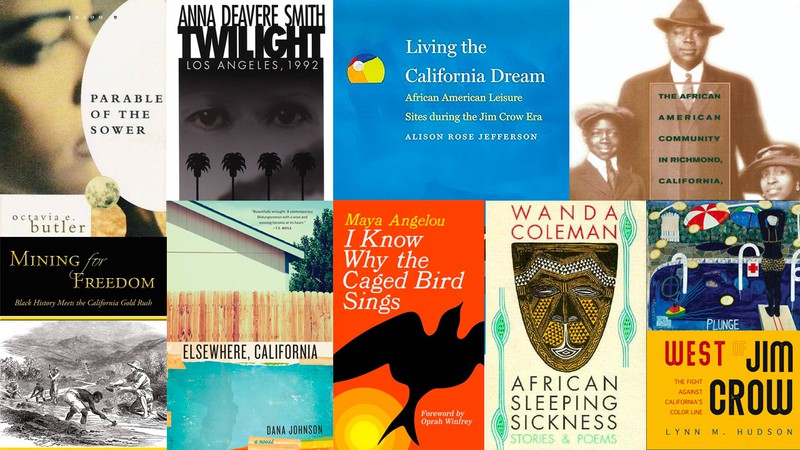
By STELLA KOTIK
Every February for almost 100 years, Black History Month has provided an opportunity to recognize the struggles and achievements of Black and African Americans throughout the United States. As we continue to celebrate Black History Month this February and beyond, it’s important to learn from those histories to understand where we are today. California Local has assembled a list of collections, novels, histories and more that feature Black voices exploring the Black experience in the Golden State since its establishment in 1850.
I Know Why the Caged Bird Sings, by Maya Angelou (Random House, 1969) With her unrivaled legacy, Maya Angelou’s famous autobiography is crucial to understanding not only racism and oppression but also the story of one of the most influential poets in the world. Focusing on the early years of the poet and civil rights activist, the book follows Angelou’s move from the South to San Francisco, where she attended high school and became the city’s first Black female cable car conductor. While the autobiography cannot encompass all of the history that comprises both Angelou and the state, it is a staple in the world of literature and Black history.
African Sleeping Sickness: Stories & Poems, by Wanda Coleman (Black Sparrow Press, 1990) Wanda Coleman’s African Sleeping Sickness: Stories & Poems is a collection of autobiographical short stories and poems featuring first- and third-person monologues that highlight life on the streets of Los Angeles. Known as the “unofficial poet laureate of Los Angeles,” Coleman and her works capture the experiences of racism and isolation that shape the city.
Parable of the Sower, by Octavia Butler (Four Walls Eight Windows, 1993) California author Octavia Butler’s iconic work of speculative fiction features a post-apocalyptic version of the state, one in which climate change and social inequity have displaced its main character. While the novel focuses on a future version of the state—specifically around the outskirts of Los Angeles—it simultaneously highlights California’s history and potentially devastating future without reform and reflection.
Twilight: Los Angeles, 1992, by Anna Deavere Smith (Anchor, 1994) Anna Deavere Smith’s one-woman play features 40 characters, highlighting real-life stories from the aftermath of the verdict regarding the Los Angeles Police Department’s violent 1991 attack on Rodney King. Following nine months of interviewing upward of 200 people, Deavere Smith assembled a diverse array of voices who historicize and contextualize the city’s 1992 riots. Considered a work of “documentary theater,” the play tackles issues of race and class amid one of the nation’s most infamous cases of police brutality.
To Place Our Deeds: The African American Community in Richmond, California, 1910-1963, by Shirley Ann Wilson Moore (University of California Press, 2001) Shirley Ann Wilson Moore’s book delves into the history of Richmond, in the northeastern corner of the San Francisco Bay Area. Featuring oral histories, archives and newspapers, this social-historical book takes a deep dive into Black migration, which brought to the city both the rise of an urban industrial workforce and cultural resources such as blues clubs.
Mining for Freedom: Black History Meets the California Gold Rush, by Sylvia Alden Roberts (iUniverse, 2008) While California is often recognized as the “Golden State,” this vision often fails to illuminate the diverse stories of those who contributed to the state’s legacy. As a historian, Roberts hones in on the untold stories of the Black Americans who not only contributed to but pre-dated the infamous Gold Rush. Reevaluating the often one-sided stories of California, the book provides a history into the unappreciated and forgotten contributions of the Black men and women who turned the state into the rich place it is today.
Elsewhere, California: A Novel, by Dana Johnson (Counterpoint, 2012) This novel hones in on Avery, a character first introduced throughout Dana Johnson’s award-winning collection of short stories, Break Any Woman Down. Now, Elsewhere, California focuses on Avery as she navigates Southern California, from Los Angeles to West Covina. Focused on representing African American history throughout the region, the novel provides a fresh and historical perspective to the coming-of-age novel—particularly for those whose stories are not frequently told.
West of Jim Crow: The Fight Against California’s Color Line, by Lynn M. Hudson (University of Illinois Press, 2020) Lynn Hudson’s history looks into the Black Americans whose migration to California was not met with the reputation of freedom and equality that is often positively associated with the Western United States. West of Jim Crow reexamines the Black Californians who paved the way for civil rights and resisted the state’s color line, featuring stories from Allensworth’s Black community to Pasadena’s segregated swimming pools.
Living the California Dream: African American Leisure Sites During the Jim Crow Era, by Alison R. Jefferson (University of Nebraska Press, 2020) Living the California Dream tackles the misconception that Western states like California were beacons of progress, examining the open operation of Jim Crow throughout various parts of Southern California. Jefferson highlights communal practices and economic development around leisure that not only challenged the politics of recreational access but marked a space of Black identity within Black and California history for years to come.
Article exploring songs, books, movies and other works from art and culture which feature our beautiful state.